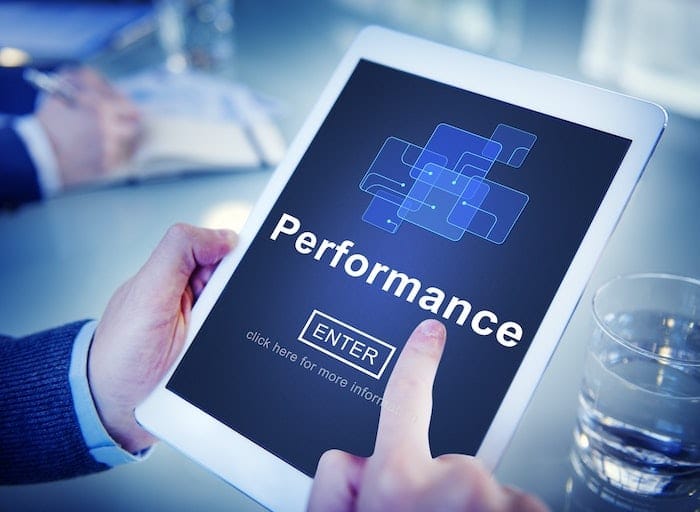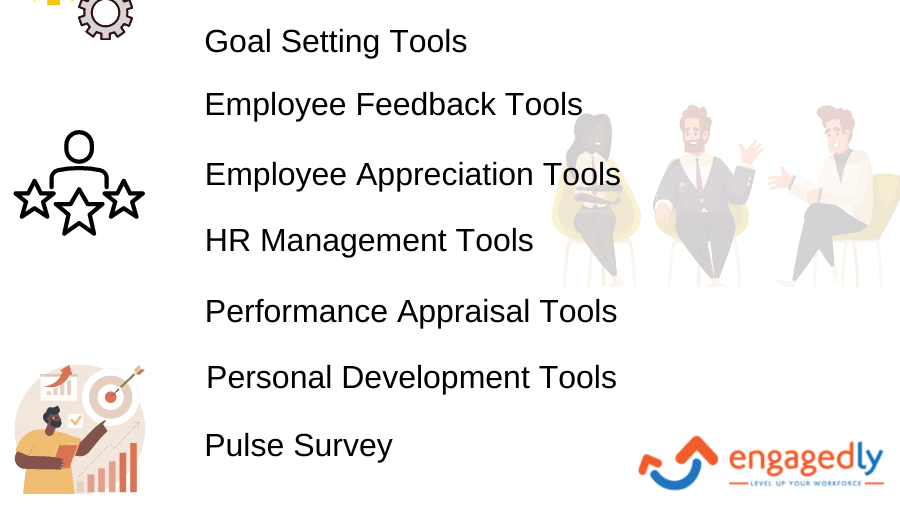Employee performance management tools and techniques are two of the critical management tools that influence employee growth and organizational development significantly.
A Gartner report shows that 95% of managers are unhappy with their organization’s present performance management practices. If you take the time to review your processes and how you can best utilize performance management tools, it can help you keep your employees engaged as well as help your business get ahead of the competition.
A performance management system includes various important HR functions, like goal-setting, feedback, rewards, and performance review.
An effective performance management system helps HR managers establish clear performance expectations through which employees can easily understand what to expect out of their jobs. Moreover, it allows managers to reinforce individual accountability to meet their goals and evaluate their own performance for employees.
Most organizations use performance management systems suitable to their needs based on factors like industry, number of employees, etc.
What is Performance Management?
Performance management is the process of establishing a motivating work culture in an organization, where employees and managers constantly review themselves and work towards a few common organizational goals.
Essentially, it includes goal-setting, goals tracking, ongoing check-ins, real-time feedback, 360-degree feedback, rewards and recognition, learning and development, and talent analytics.
What happens in an organization that doesn’t have a performance management system?
It fails to motivate its employees and leaves them directionless and disengaged. A system helps an organization build a skilled and efficient workforce, which increases its overall productivity. Here are some tools you can utilize to draw the best results.
Also Read: Download the ultimate guide to employee engagement survey and templates
7 Performance Management Tools in 2024
1. Goal Setting Tools
Setting proper goals for employees is one of the initial steps that leads to increased employee and organizational productivity.
It is important to define performance plans and objectives clearly. Having plans that are open-ended and unclear creates a lack of interest in employees. At the beginning of the year or at the
beginning of the quarter, managers meet with their employees and set clear goals and objectives for them. In this phase, managers plan on ‘how’ their employees should fulfill their goals and accomplish results. These goals should be SMART and challenging.
We recommend the use of goal-setting tools that help you create objectives and key results (OKRs and KPIs) and align your individual goals to those of the organization. Performance management tools like Engagedly can help you use OKRs and get the best out of them.
Also Read: 7 Reasons Why Goal Setting is Important
2. Feedback Tools
Frequent employee feedback is one of the best practices for tracking employee progress and improving it from time to time. This practice helps not only employees but also the team and the entire organization increase their productivity.
While most organizations already have digitized the process of employee feedback, many organizations claim that implementing a feedback tool has helped them create a culture of frequent feedback, which in turn, promotes employee engagement. These feedback tools also include 360-degree feedback and peer-to-peer feedback.
Encourage your employees to come forward and share frequent feedback with their managers. This practice helps you build a culture of trust and continuous development. Using employee feedback software can make this practice easier to implement. Engagedly allows users to share, receive, and request feedback from their managers, team members, and peers.
3. Employee Appreciation Tools
Most employers forget to appreciate their employees’ good work, but they specifically remember to criticize when something goes wrong. This practice not only promotes disengagement but also creates a sense of dissatisfaction in employees, which directly affects their productivity. So, always remember to appreciate and recognize the good work of your employees.
Using an employee recognition tool could be the start of changing your company culture to one that promotes appreciation and recognizes employees for even the smallest of their progress. Engagedly allows you to recognize and praise your employees socially for any contribution that they’ve made to the organization.
4. HR Management Tools
HR is undoubtedly one of the most crucial functions in any organization. Managing employees manually is time-consuming and exhausting for HR personnel.
Therefore, having automated HR management software at your organization can ease many daily HR activities and solve many HR management issues.
When looking for HR software, there are many things HR managers need to consider, such as ease of set-up, strong data security, good customer support, powerful performance management, etc. Besides those features, it is also important to find a performance management tool that can adapt to your needs and grow with you.
5. Performance Appraisal Tools
When it comes to having a performance management tool in place, performance appraisal is possibly the most ordinarily used one. It’s a powerful tool that can help an organization align its goals to individual ones and track their progress and performance over time.
But if you are looking to derive the best results out of this tool, you need to make sure that the appraisal process is a regular, fair, and constructive two-way conversation between your employees.
If you fail to create an environment where your employees can speak freely, they will get demotivated and will not stay with the organization for too long.
Also Read: Performance Appraisal Software: Why do you need it?
6. Personal Development Plans
A performance development plan is a very effective mechanism for building up employee performance. Both managers and employees benefit greatly from the PDP process, which helps in identifying areas for growth, strategies to achieve that growth, goal setting, and tracking. Some key benefits of the tool include:
- A definite path to achieve goals
- Measurable goals, improvement, and results
- More distinctive alignment with organizational and team goals
- Definitive employee development and accountability
The PDP process encourages and motivates employees to direct their growth toward organizational progress. It helps streamline the performance process and inspires success. Engagedly’s LMS (Learning Management System) can help your organization in setting this process up for your employees.
7. Pulse Survey tool
Pulse survey tools are a simple, powerful, and flexible way of collecting employee feedback and reading the pulse of your employees. The result can help you understand your employees better and, in turn, can help your organization strategize for better employee engagement.
Proper engagement surveys come from a well-set intention and well-defined goals. Moreover, they need to be frequent enough to show trends in temperament and attitude. If the intention is unclear, these surveys will ask unimportant questions and receive vague responses.
In such a scenario, it won’t be compelling enough to take any action. Read here if you wish to know more about pulse surveys.
Performance Management Techniques
Organizations must have an effective performance management system. But no matter how good the system is, its success depends on the managers who implement it.
1. Plan
The planning stage comes first. Here, you define individual goals & strategies clearly and communicate them organization-wide so that your employees understand that meeting their individual goals contributes to the organizational goals.
Coordinate with your employees before setting up their individual goals and make sure that the goals are SMART (Specific, Measurable, Achievable, Relevant, and Time-bound).
Also Read: How To Write Good Employee Goals & Objectives
2. Monitor
After you define the goals and strategies for your employees, you should constantly keep track of their improvements and take care of their developmental needs. Monitoring continually means providing ongoing feedback and consistently measuring employee performance.
It helps you check if the employees are meeting their goals as planned.
3. Rate
Rating means evaluating employees based on their performance standards. Though this step is a part of monitoring and giving feedback, it is considered a more formal way to evaluate employee performance. It also helps managers know who their best employees are.
Rating employees at regular intervals helps them improve themselves. It also helps managers look at and compare performance over time or across a set of employees.
4. Reward
Effective managers understand the importance of rewarding employees who perform well. Employees feel empowered and motivated when their work is recognized.
This leads to increased productivity in the organization. So reward the employees who meet your expectations or exceed your expectations.
5. Upgrade
Keep upgrading the goals & strategies at regular intervals. If your employees feel that their existing goals seem unattainable or that they have a negative impact on the organizational work culture, then it is time to coordinate with your employees and change them.
6. Mentor and Coach
It is said that there are no such things as poor performers. So if there are employees in your organization that are showing up with mediocre performance, then they are just waiting to be discovered for the right talent that they have.
With coaching and mentoring tools in place, your organization can bring out the best in every employee. If tapped right, can you imagine where these tools can take your organization?
The growing divide between employees and organizations has made it difficult to engage the workforce and lead them to a path of optimal performance.
Leaders need to be cognizant of their employees’ needs and take a progressive approach to meeting them. Performance management tools and techniques help human resource managers find blindspots and take corrective action.
Which performance management tools do you use in your organization? Let us know in the comments section below.
Frequently Asked Questions
Q1. What are performance management tools?
Ans. Performance management tools are real-time software that helps managers and leaders track the productivity of their team members. With the help of an inbuilt data management system, these tools organize and interpret the data to get productivity insights into the organization. These insights further help leaders in making informed decisions for organizational growth.
Q2. What are the four stages of performance management?
Ans. The following are the stages/cycle of performance management: Planning, Monitoring, Reviewing, and Rewarding.
Q3. What are some of the performance management tools?
Ans. The following performance management tools are highly beneficial for businesses: goal setting, real-time performance analysis, surveys, Real-time feedback, learning and development, and 360 performance reviews.
Q4.What are the 5 elements of performance management?
The five elements of performance management are setting goals, tracking progress, developing skills, giving feedback, and evaluating results.
Q5.What are the 5 pillars of performance management?
The five pillars of performance management are planning, monitoring, development, evaluation, and rewarding achievements.




